July/August 2023
Ziggin’ and Zaggin’ in the Prairie Provinces
“You make enough left turns, you end up going around in a circle.”
We had spent the early part of July in South and North Dakota, and now on July 16 we were ready to move on into Canada. We had lots of plans for our time up here, some of which worked out and some that have been set aside for another day. But all told, it’s been fun, lots of fun, and we’re now perched on the south side of the border again, having just crossed into the Great State of Montana.
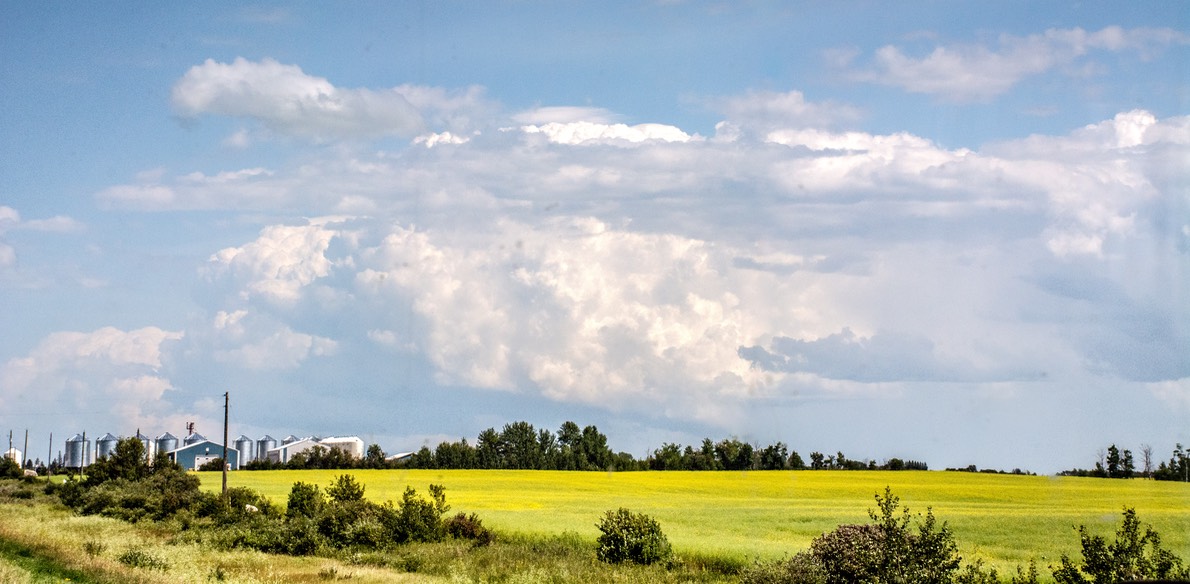
So what’s the deal, you ask? Why have we not heard from you in absolutely forever? (You know, it happens regularly, doesn’t it; we don’t stay in touch very well. Sorry ‘bout that.) Many of the issues are just all the usual — life intervening when you’re having a good time. But this year, at least during the last bits, we’ve been dealing with smoke and fires and the need to stay away from both. Oh, and there has been the occasional mechanical difficulty as well. But we’ll get there. All will be made clear.
Our overall plan for the summer was to explore the southern and middle parts of the provinces of Saskatchewan and Manitoba, then meander further east to a folk music festival in Ontario province on the shores of Lake Superior. We’d stay until we’d gotten to a point where we were getting too cold to stay north any longer. And then retreat to Alabama for the winter. Nice plan, but you know what they say about plans…
So! Saskatchewan, here we come, we said. One of my big goals for this part of the trip was to be able to type Saskatchewan quickly and correctly, without stopping to confirm each letter as I went along. And I can assure you — YES! The deed has been done. Saskatoon, too, although it’s not as hard.
We crossed the border coming north from Williston, ND in lovely sunny skies. North Dakota had been getting a bit smoky, then today all was clear and sunny. The border crossing was easy, and she didn’t even take away my eggs. A great start! We drove about 80 kilometers (50 miles) and stopped in the town of Weyburn. We needed new money, and time to get used to changing to the Central Time Zone. And that, of course, was the first hurdle. Saskatchewan is on the CTZ. But as we were to learn, they don’t move the clock forward an hour in the summer. Huh? We didn’t figure this out until after a few days, but it’s true. Alberta, west of them, is on Mountain Time, and does DST. Manitoba, to their east, is on Central Time, and shifts the hour appropriately for the summer as well. But Saskatchewan goes their own way like Arizona in the US. In Winter they share time with Manitoba while in Summer they are sort of pseudo-Albertans. We think.
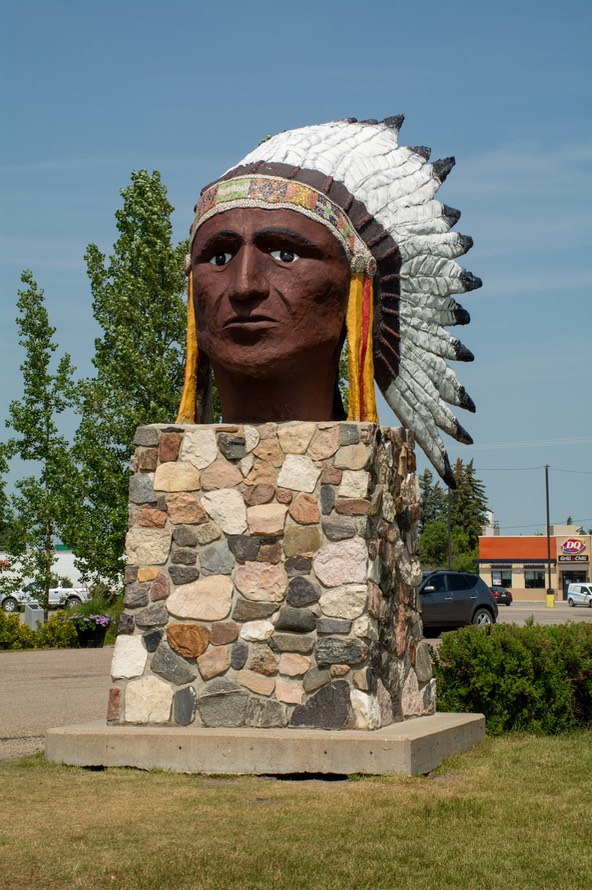
Whatever; we learn, we adapt, we move on.
We stopped at the first visitor’s center we spotted, wanting to get some ideas for where to go exploring. The town of Indian Head had a wonderful lady manning the desk and she made good suggestions, and also explained about the time zone thingie. And they had a large, elegant carved Indian head in the parking lot. Cool. As it turns out, there are plenty of such charmers all over the prairie provinces. A pretty good gimmick to make the tourists (that’s me!) seek them out and take fun photos. We have several to share with you.
Soon we found we’d already spent a couple of weeks poking around in some of the various curious corners of Saskatchewan. We ended up going around in circles a bit, because we made a plan, and then met some new people who had some great ideas for things we had missed earlier. So back we went. And one new reality we had to deal with was that the secondary (and most of the primary as well) roads are in poor shape and really take their toll each day. So we’d wander, then stop for a couple of days, then wander some more — and if we were covering familiar territory for a second time, we tried a different road. Not that it helped all that much. And, we found a similar situation in Manitoba. The Prairie Roads take it in the shorts. But the countryside is beautiful. Even more so than we’d expected.
Saskatchewan is filled with fields of grain — barley, wheat, flax, canola (which we used to call rapeseed), oats; you name it, they grow it. Not many trees in most areas. Around farms, and in recreation areas, in towns. That’s about it, at least in the central and southern part of the province. Just fields. Some folks say that’s pretty boring. Not us. The fields are lovely to see, the plants wave gently in the breezes; some are in the flowering stages right now and smell wonderful. The canola is shocking yellow, and the flax is a light blue.
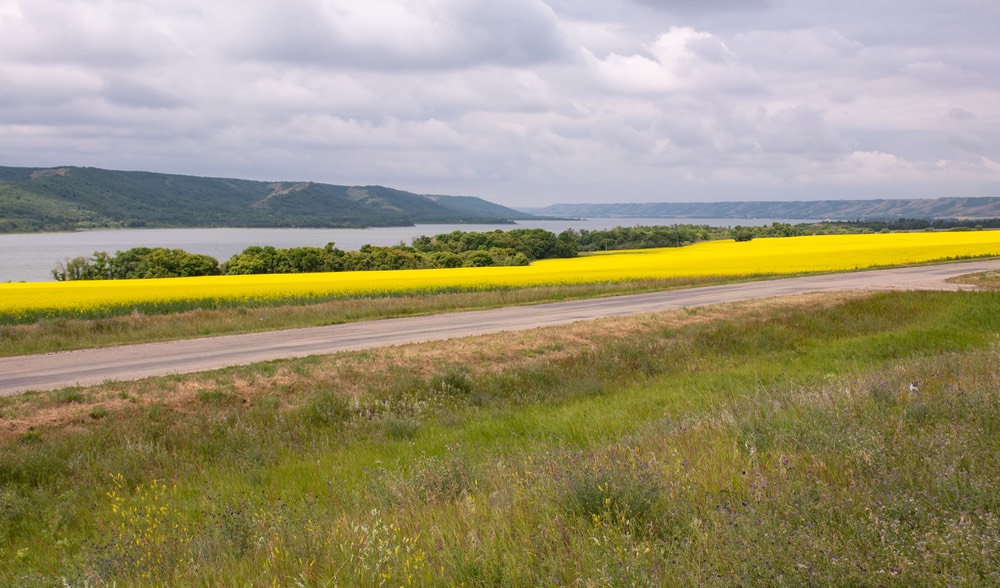
Now, in July, if they aren’t blooming they are a rich green color. Almost anywhere you park for the night the fields are all around you; it’s grand. Mostly there are these enormous vistas of bright yellow flowers; we were reminded of the wildflower Super Bloom we’d seen earlier in the year in California.
Yes, it’s mostly sorta flat, but then not really. You can’t quite call it rolling hills, but it isn’t actually flat either, at least in the south where we were. Then sometimes you come around a turn and drive into a ditch. Well, almost. The road dips down into a valley — long and pretty narrow, with a stream down the middle and often with ski runs down the flanks. No, there are no long alpine runs, but I did see the occasional short ski lift, and I suspect people do some cross-country sports as well.
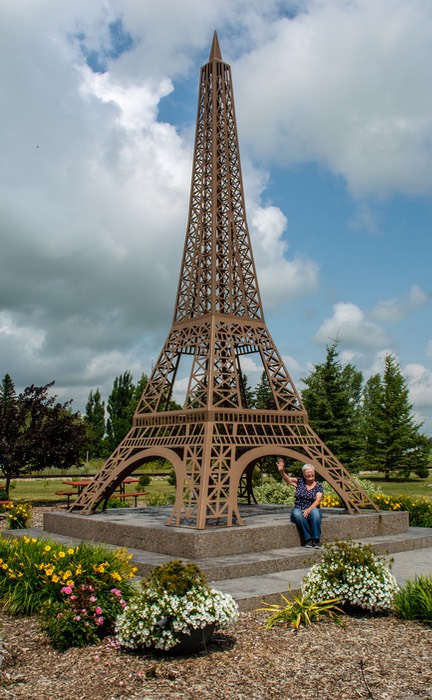
It’s actually pretty cool; and small resort areas are along for the ride. These areas are busy year-round. We drove through one of these areas, the Qu’Appelle Valley, which is quite popular and very developed. It’s along a series of lakes known as the Fishing Lakes. Profound, huh! We’ve been told that these valleys were carved by the ancient glaciers.
Ducking down a bit further south, we detoured to the small town of Montmartre, complete with its own very nice (ta da!) Eiffel Tower. Like I told you, every town wants you to come visit. It’s a nice tower, near a Co-Op grocery which had a great selection of ice cream. I also wanted to stop by in the hamlet of Kipling, to see The World’s Largest Red Paper Clip, but Rick wouldn’t buy that one. Not on these roads, he said.
We have a general policy of staying out of large cities, and we did fairly well this summer. We managed to skip Regina, with the help of a ring road which was showing off a beautiful display of black-eyed Susans and swung us right around and tossed us out near Moose Jaw.
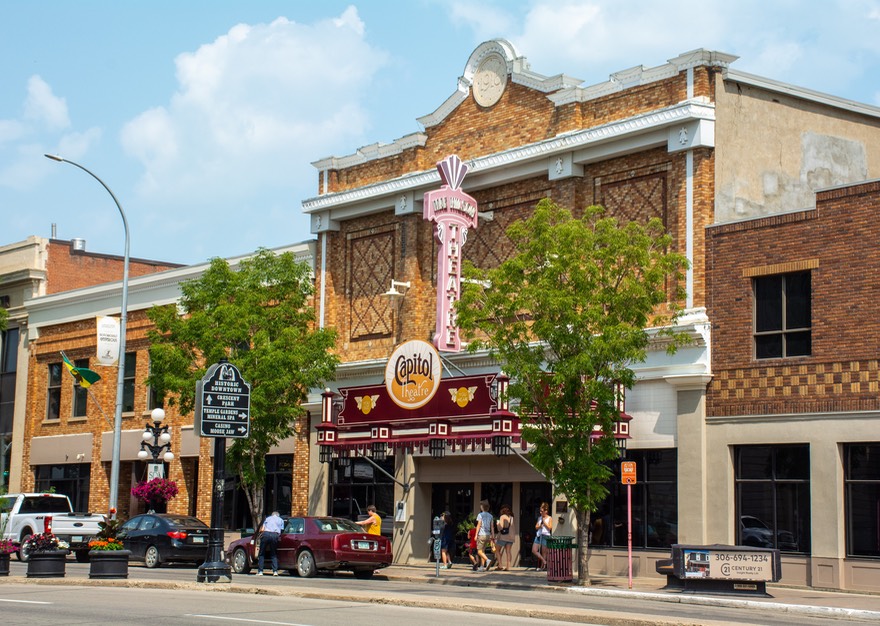
We liked Moose Jaw — lots. It’s a town with an interesting history; apparently during the 20’s it was the major source of liquor heading down to Chicago and Al Capone’s activities. You can take tours of some of the historic points. We spent our time wandering in the core of the city, looking at the great murals on the buildings, along with checking out some other bits.
The Visitor’s Center is a great place to start. Upon arrival, you’re overwhelmed with Mac the Moose, a huge presence in the parking lot. He’s quite a hunk. The Visitor’s Center has lots of info, and you can get a trolley that takes you to all the sights around town.
We were there mostly to see one of Saskatchewan’s best museums. There are four of them in this province, under the umbrella of the Museums of Western Development, this one focusing on transportation. The three others, all telling other parts of the story of Saskatchewan’s growth, are located in Yorkton, Saskatoon, and North Battleford. We did get to Yorkton, but skipped the other two, as their subjects were less interesting to us.
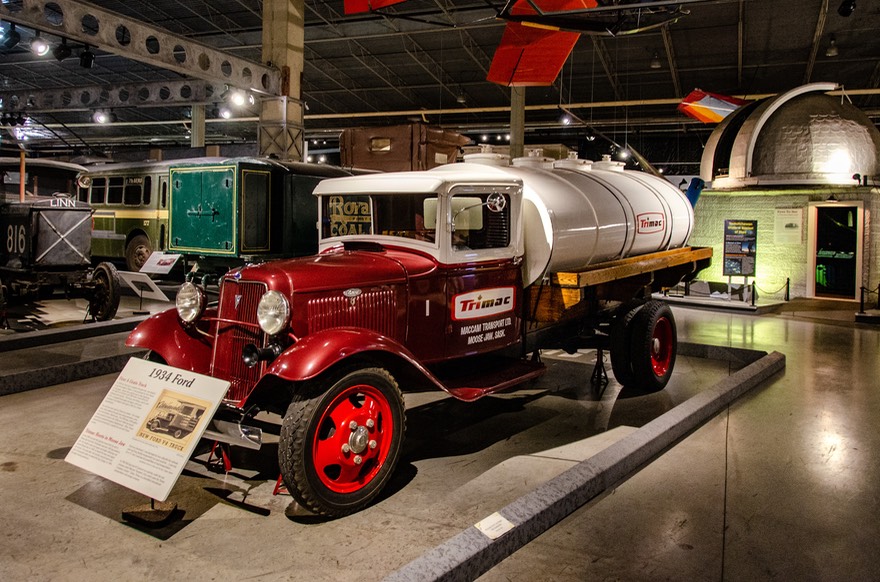
The museum is full of info and displays about the development of machines of all sorts, along with a corner filled with home life on the prairie. There would be more similar kinds of information in most museums in these provinces we were visiting. There was much to share. The mechanical stuff was all pretty cool, and there were lots of “small” bits of info that were fun to learn. I liked reading about an old saying —
When a horse is restless
and paws with its hoof,
You’ll soon hear the patter
of rain on the roof.
So much for Accu-weather!
The Moose Jaw MWD museum turned out to be larger and more interesting than we’d anticipated. It had a large collection of older cars, some steam locomotives, a dozen or so airplanes and even a few boats thrown in as well. Displays and information panels were nicely done. Altogether a nice experience. Go to our Motor-Museums site to see plenty more photos from there.
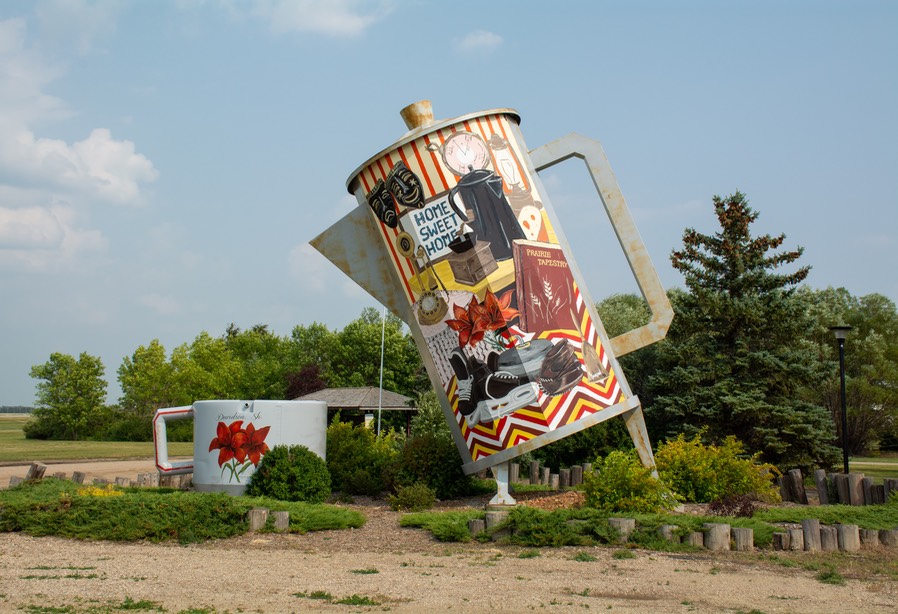
One of the most interesting (to some of us at least) was the story behind the development of the Evinrude outboard motor. It seems that Ole Evinrude and his fiancée, Bess, were picnicking on an island out on the water, and she was interested in some ice cream. All he had was his rowboat, which he took across the water to the nearest source of same. By the time he got back all the goodies had melted. This was totally not cool, and he started thinking about ways he could build a motor that could be attached to the boat when needed. Pretty nifty!
Finally leaving Moose Jaw, I demanded an opportunity to see The World’s Largest Coffee Pot, located in Davidson, which was not too far up the road. Kind of fun to look at, but couldn’t compete with Mac the Moose for sheer drama. It was more on the level with the Eiffel Tower of the Prairies.
We also tracked down and stopped to visit with the owner of a company, Prairie Berries, that grows and processes the famous local Saskatoon berries; sometimes known in the US as June Berries. These look like blueberries, although the color is more purple, but they are actually closely related to apples, not blueberries at all. The pies made from these berries are quite something! We had bought some jam at the museum, and they had helped us get in touch so we could get ripe berries to enjoy as well and a pie for ourselves and even a free sample of chocolate covered berries. It was fun. We learned about the processing and how the business had been developed. An interesting bit of information was that ten years ago the business hired a nice fellow from Nicaragua. He worked out so well, and is still there and now a Canadian citizen, that now virtually the entire crew is from there, mostly his own family and friends, working on the berries and also on learning English and getting their citizenship. We had a nice visit to Prairie Berries, not far from Moose Jaw.
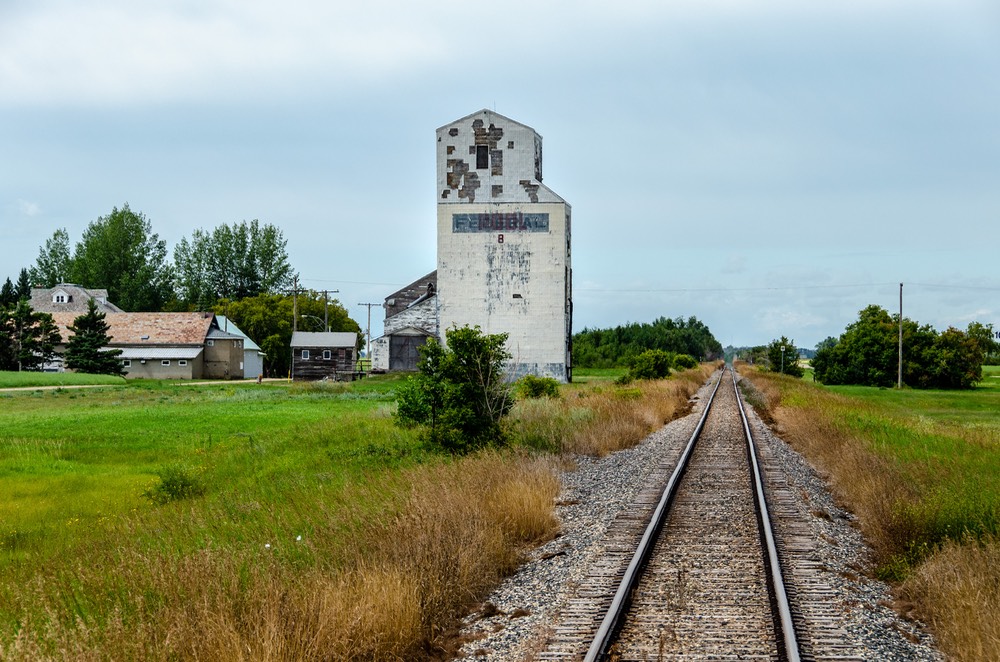
We’re starting to see a blue color out in the fields now. No, not berries. In asking around, we’ve found that the blue is the flowers in the fields of flax. It goes beautifully with the canola, which is the stunning yellow we’ve been seeing everywhere. A great combination.
The skies are a bit hazy now, and we’re coughing a bit from some smoke coming down from the northwest. But we’ve turned eastward now, heading toward Yorkton, our next big destination. And oh, my! The quality of the roads is getting even worse than before. We came east on a road that was completely torn apart. I might have turned around and found a different one to try, but Rick was sure we’d be just fine, and — of course — we were. Narrow winding spots down hillsides and up the way beyond, plenty of mud from recent rains, more signage than workers, but we made it through fine.
We were very glad, because we were heading for a spot we’d heard about that sounded really neat — and it was worth the effort. It was a great historic spot turned into a rest area where you can hang out as long as you wish. Located on the site of an early Hudson Bay Trading Post, called Touchwood Hills Post, there are nifty info plaques and it’s located next to a huge field of hay. The bushes of berries are almost ripe; there are frogs out in the misty early morning; and plenty of birch trees to admire. This was one of several local parks we found that are set aside for public use, including camping.
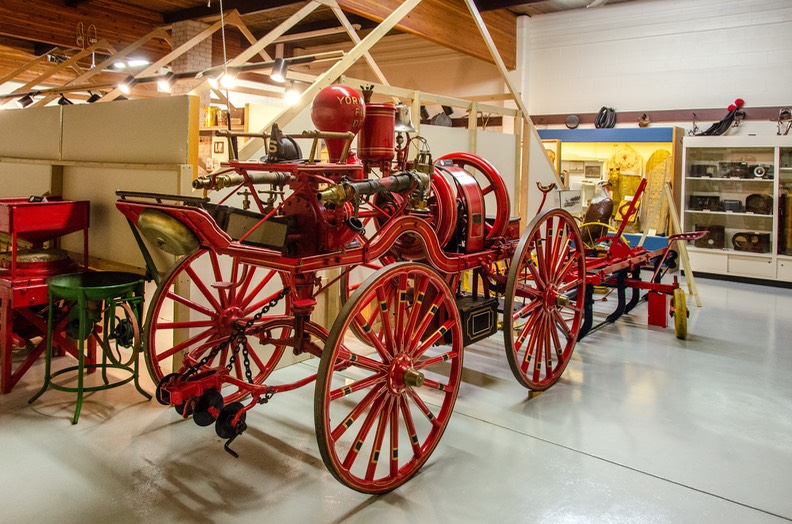
We arrived in Yorkton with a short list of things we wanted to do and see. First we went to Yorkton’s Museum of Western Development. I enjoyed learning about early settlers and their lives; there was lots to learn, particularly about the early Ukrainian settlers, which was very interesting. The Canada guidebook we’ve had for several years indicated that there were some early automobiles to be seen here, but they’d been moved to Moose Jaw back a bit and we’d already seen them. What they did have, if one were interested, was a large collection of old farm equipment stored outside; tractors and threshing machines and such. Not really our thing, so this branch of the provincial development museums didn’t keep us as long as Moose Jaw had.
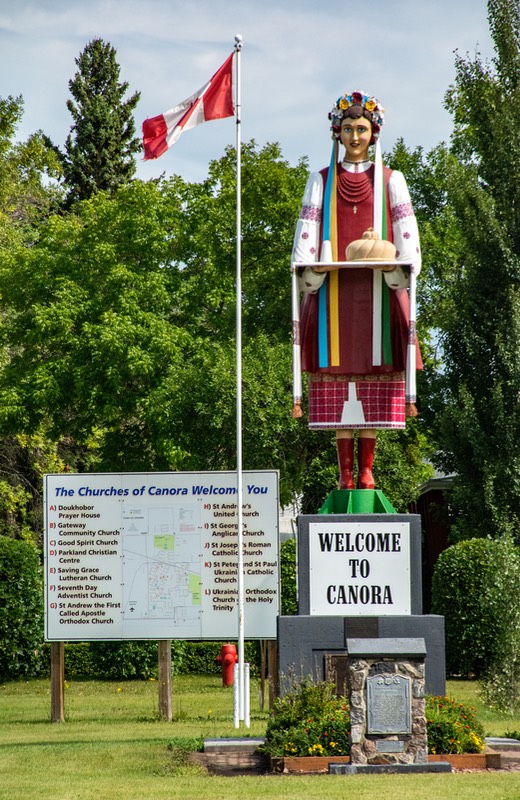
Along the way we learned that there had been lots of Ukrainian settlers in Saskatchewan and Manitoba back in the late 18th and early 19th centuries, and we enjoyed visiting several old churches and museums to learn more about them.
One church visit led to a change in our itinerary. While I was taking some photos, and discovering a plaque that talked about its history, a local fellow stopped to talk; for many years he had been involved in that church, the St Joseph Ukrainian Church. He and I walked around while he pointed things out to me. The church was no longer very active, and was locked to the public (as are all the churches apparently unless services are underway). But he was quite interesting to talk to, and knowing we were interested in Ukrainian artifacts and history in both Saskatchewan and Manitoba (where we were heading next), he made some suggestions about some other towns in the area.
Taking his advice, we squiggled around a bit and went further northeast, trekking first through a very nice Ukrainian enclave in Canora, where we were greeted by a Ukrainian statue at the entrance to the town, and an incredibly gorgeous church to enjoy. Super duper. Canora was one of many beautiful small towns we were able to see all across the prairies. They look like really nice places to live.
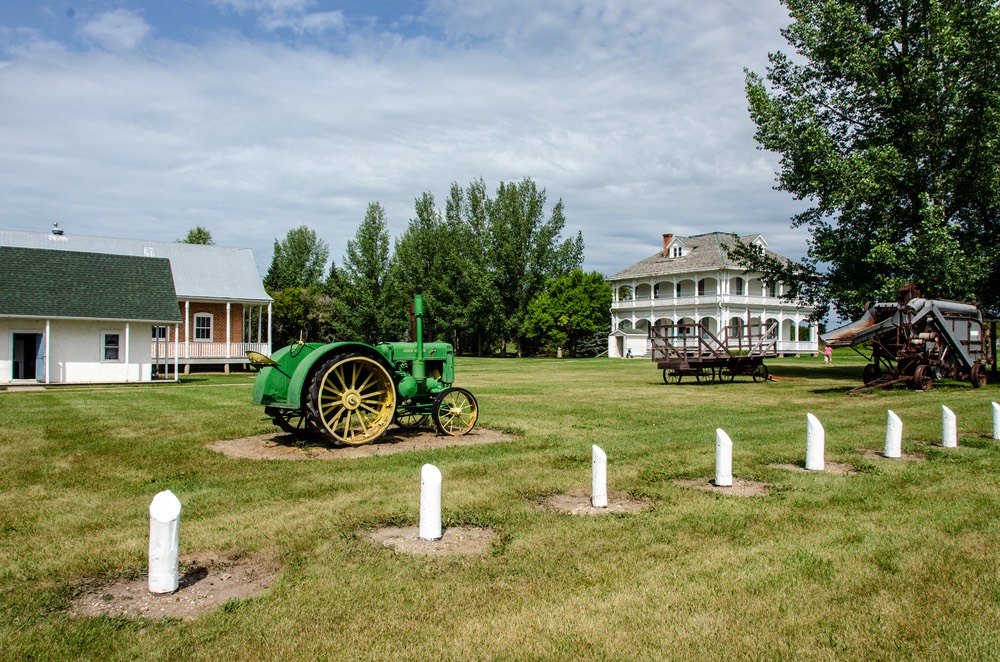
We then proceeded to Veregin, home of the National Doukhobor Heritage Village. The land upon which this community lived was, in part, donated to Leo Tolstoy by Queen Victoria. There’s a statue of him on the property, although he never visited Canada. The prayer house where the leader of the sect lived is a lovely, quiet country home. Inside there are wonderful old photos of the early residents. A great place to visit, and we spent a lot of time poking around.
As a sidelight of our time in Saskatchewan, we (that’s Kathy talking now) had been developing an interest in the grain elevators that the prairie provinces are famous for. They are just about everywhere, scattered across the plain, and stick so far up from the flatland that you cannot fail to spot each of them. We’d been taking photos as we went along; most of them are definitely still on the job. Their job, of course, is to store the grain until the train can come up and take the harvest away. And, therefore, each of them is accompanied by a train track, and the trains are scattered everywhere. Such is life on the prairie.
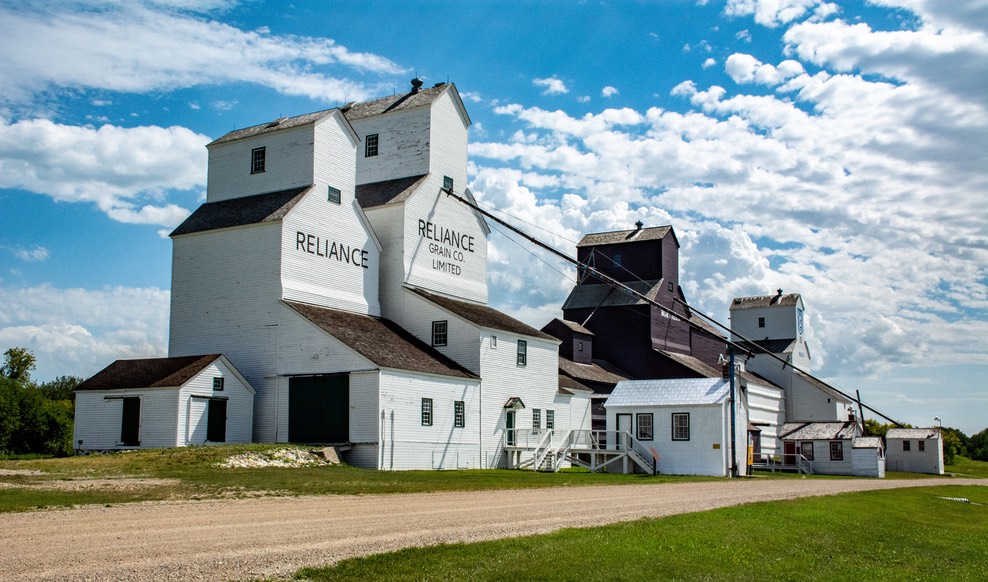
By now, we were massing at the Manitoba border. We had several places we wanted to visit in the western part of this province, the first being Inglis, home to a group of silos that had been renovated and given heritage status. We’d seen them many years ago, on a trip through Manitoba along about 2005. Well, they are clean and neat and all lined up, but they used to be painted in a lovely colorful array and now they are all white and spiffy and not as visually interesting. Still, we were glad to see them again. They are just east of the western Manitoba border, so we went due south from there to the small border town of Russell, where we got fuel and groceries.
We checked out the visitor’s center, but they didn’t have much, and they had a cow statue parked out in front someone was trying to pass off as a buffalo. Not overwhelming. But we did come up with a map of small communities and places where immigrants had settled in the area. Intrigued, we managed (not without difficulty — it wasn’t a great map!) to locate some of these places, and to visit. It gave us a nice opportunity to learn more about the area and the people who came here from other parts of the world.
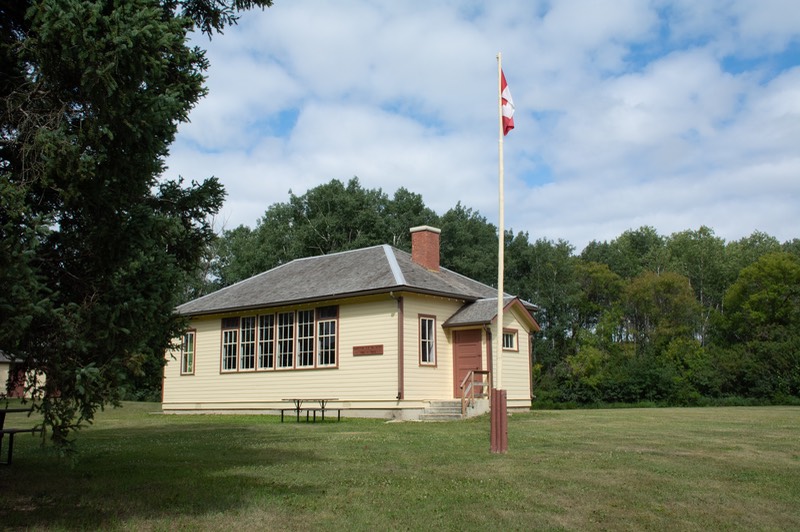
Not too far along, we stopped outside the town of Rossburn to visit a heritage site called the Marconi School. It had been the public school for the rural community there, a one-room schoolhouse, still in very good condition although it was in operation from 1928-1950. At some point a group of alumni had gotten together to raise funds to restore the building. It’s in a quiet little spot deep in the forest off a small road through the grass, near a river, and a lovely place to sit and enjoy out in the countryside.
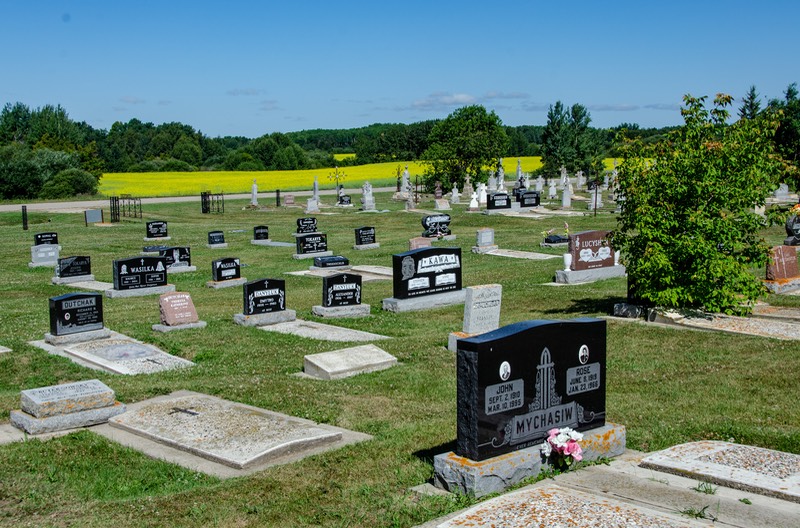
We also poked around in several other little spots where we had been told there were cemeteries, collapsed housing, and more churches. In Olha, a tiny one-building (post office and grocery all in one spot) wide spot, there was a replica of tent-like primitive housing was installed by settlers to live in while they constructed more permanent homes. Olha had quite a history, and some of it is told on plaques in the area. We visited a beautiful church and cemetery with canola still in bloom across the road.
By now we knew we needed a break, so we headed for Riding Mountain NP, where we knew there were quiet spots, the possibility of bison and elk to see, and perhaps other critters. We stayed there for several days, in a campsite not far from the lake. It was great. The main focus of attention for visitors in the park is the area near the central lake region, Wasagaming. There are lots of activities, a lovely lake, good food, and a very full campground. But… if you go north up to the top of the park, there is a second, very quiet, non-reservable campground at Moon Lake with plenty of room, walking trails, peace and quiet (oh, did I already use that word?), a joyful area in which to recuperate.
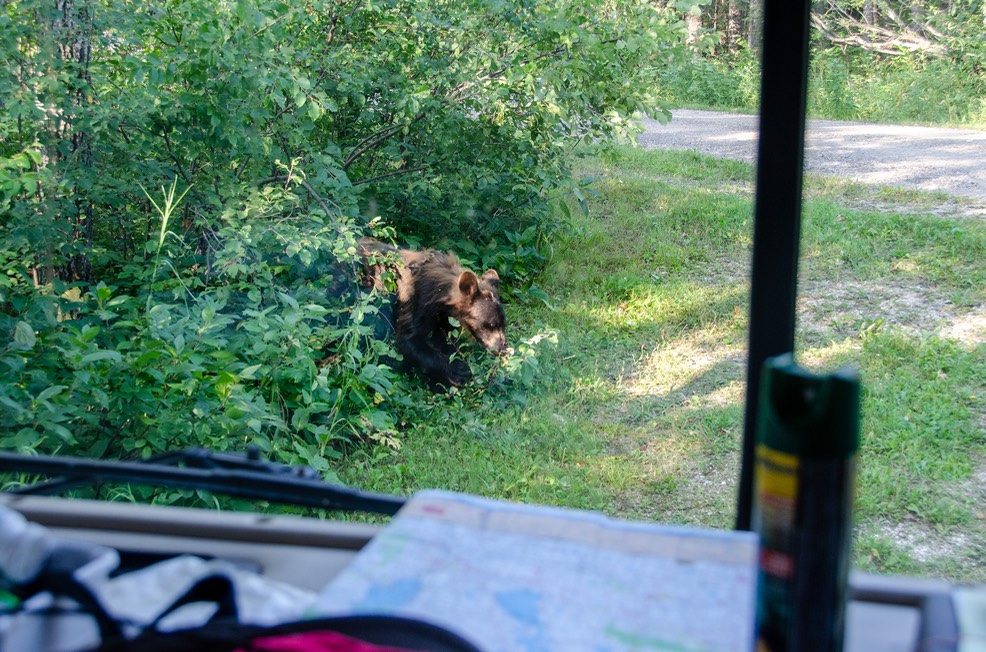
Which we quite happily did. Beautiful park. We’d been here once before, many years ago, and were pleased to return. And the highlight??? This time we had a bear in our campsite!!! Young, it was full of purpose — to eat as many of the berries as could be held in one’s paw at a time, and then grab the next handful as soon as he could let go of one branch and grab the next. He was such fun to watch, and we even got some photos to share with you. The best adventure of our visit!!
From Riding Mountain, a ways west of Manitoba, our plans had been to keep moving east until we hit Winnipeg, then carry on into Ontario and end up at a musical event east of Thunder Bay. Some of you know this already.
But now some personal issues intruded, and we reversed course. A friend back in the west was dealing with some unexpected problems and we wanted to lend some support. If we continued eastward it would be impractical for us to come all the way back so a change of plans was necessary. We would spend a bit more time here in Manitoba, then head west again, cruising through some parts of Saskatchewan we’d not seen earlier, then through Alberta and a small bit of British Columbia, heading back into the States along about the Idaho Panhandle. All a bit vague in the telling, but cementing itself into a real plan as we worked our way along. And thus our summer in Canada took a bit of a twist and became a more circular route rather than the linear plan we’d had before. All part of the joys of full-time travel.
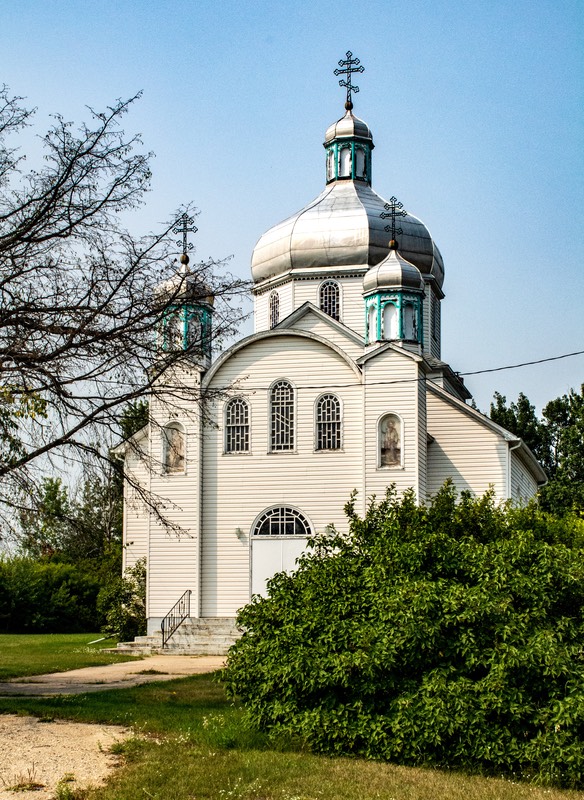
The summer has continued very pleasantly, and has evolved as life always does. While still in Manitoba we checked out more interesting places. Ethelbert was our first target. This is a small town north of Riding Mountain, and we loved it. Never did find out how it got its name, but how evocative is that one! The Ukrainian Orthodox church at the end of the road where we parked was very nice, as was the small community play area that kept the wee ones fully entertained. A charmer.
We also swung through Dauphin (Dawfin to the locals), which has a reputation of being very Ukrainian and interesting. Well, they were very busy getting ready for a festival in a few days, chaos reined everywhere, and we couldn’t find anyplace open that could sell us what we were looking for — a Ukrainian flag. Ah, well. Somewhere else.
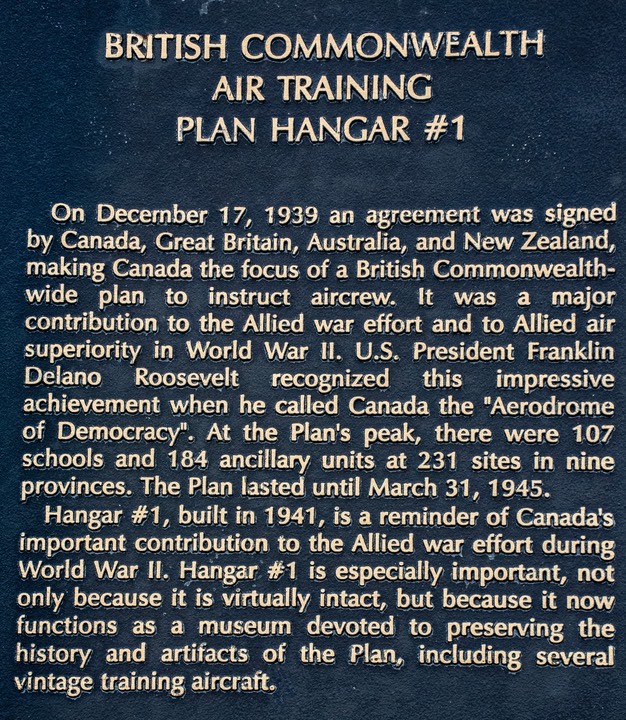
And we braved the city of Brandon. They call themselves The Wheat City. There is a really interesting airport on the outskirts, with a different sort of aviation museum we’d read about. We also passed by a bakery named Kuipers in town, with absolutely smashing… well, everything. We grabbed some bread, cookies, cinnamon buns and tea scones; and it was all really good, especially the cinnamon buns. And we got a good deal on some splendid fresh corn.
The air museum was the confusingly (to the Americans on hand) named CATP Museum. This stands for the Commonwealth Air Training Plan Museum and it is meant to commemorate the WWII international effort to train air crews and maintenance personnel from Canada, Australia, New Zealand and other members of the British Commonwealth for the war effort. Much like the similar program in the US, there were bases scattered throughout the country turning out hundreds of thousands of pilots and others to fight in the war. As an aviation museum it was pretty mundane, but as a place to memorialize the massive effort involved it was well worth the visit. We happened to visit this museum on my (Rick) father’s birthday of August 4th. As he was both an RAF veteran from the 20s and a US Army veteran from WWII, I made a note in the visitor’s book in his honor.
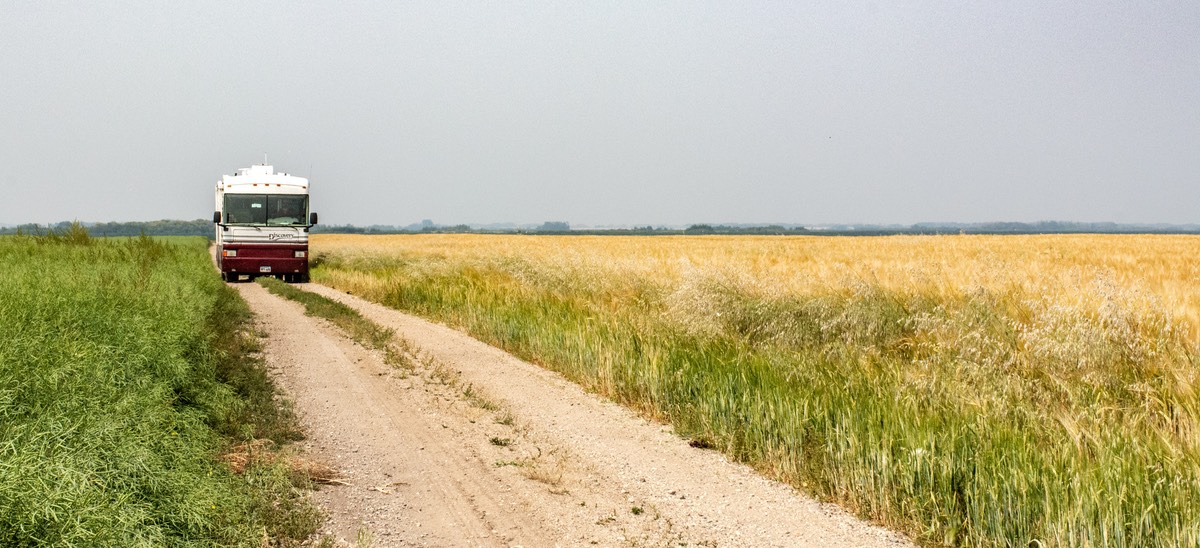
Eventually we escaped Brandon, which was rebuilding one of the entrances to the city as well as one of the bridges over the river, thus causing an amazing amount of chaos in all directions.
Going west, back into Saskatchewan, we saw the crops were now noticeably further along. The wonderful fields of yellow flowers were being replaced by the soft green color of canola plants - on the left in this photo; while the green of early growth in the barley and wheat fields had become a lovely shade of golden tan (barley) - on the right - or just normal tan (wheat). It was all still pretty, just different. Some of the small lakes and ponds were starting to have a little less water in them.
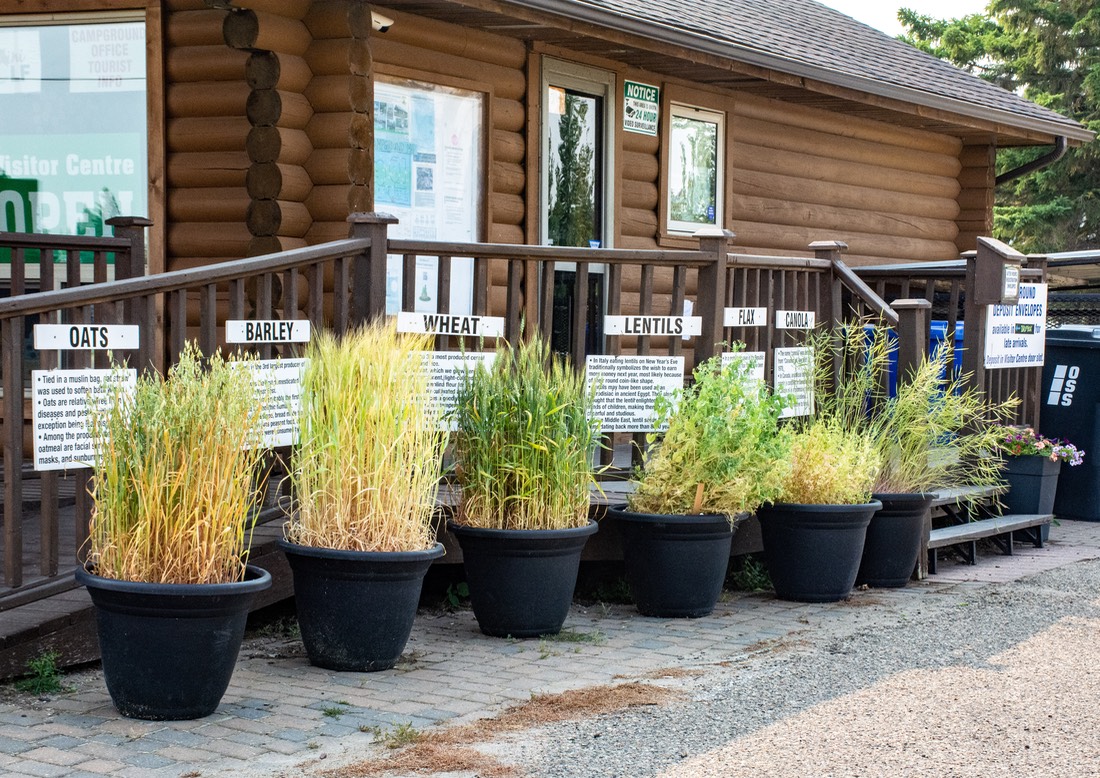
We stopped a night near Foam Lake, out in the middle of nowhere. Free spot in the trees with grass under our feet, and right next to a field with a huge vegetable garden - a beautiful location. Nearby was a visitor’s center with barrels filled with the various crops we were seeing along the roadsides. The young lady inside said “We’re starting the barley harvest next week. Supposed to rain a few days later so then we’ll have to wait until the fields dry out before we can do more harvesting.” The barrels were revelatory to us non-farming folk and helped us to know what we were passing as we drove along. Cool! After all, who knows a Canola crop once all the yellow flowers are gone?
We drove north into birding areas with small lakes/marshes/ponds and lots of opportunities to wander the back roads of nowhere. Saskatchewan is really lovely!!! We spent some time at a pond on the edge of a marsh, hoping to see lots of birds, but they’d taken the day off; or, more likely, won’t be back ’til October. But we chatted with a local rancher who offered some other possible places to head for; this is great country, near the Redberry Lake Biosphere. He was a friendly guy who comes out every couple of days to make sure his cows are still where they belong.
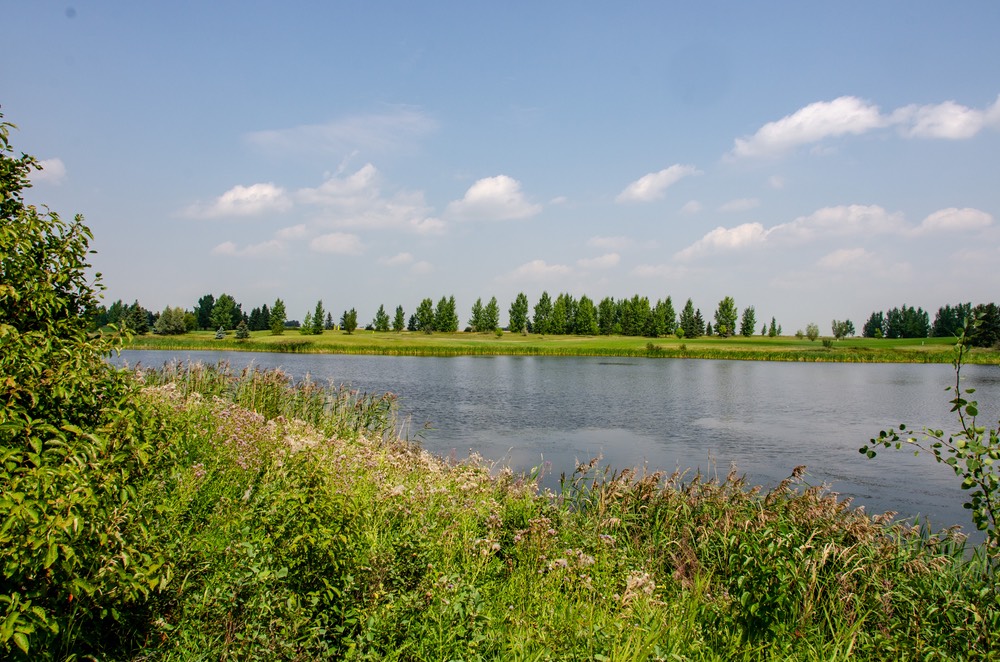
The Friday “August long weekend” was upon us. No idea what was being celebrated, just knew there might be more folks out on the roads. On Sunday we stopped in the town of Humboldt to stay in a local park. There was a pond with various birds, including white pelicans (which startled us West Coast folks), a play area and walking trails; and very near a golf course. Very nice spot, but when we went to leave on Monday the coach wouldn’t start. Oops! Thus began what became a nearly three week effort to isolate and repair this new problem. Needless to say, this was another unplanned outside influence that would affect our ability to plan our travels.
As Monday was a holiday (turned out it was Province Day) no help was available, but on Tuesday morning, on the recommendation of some passing locals, we got on the phone to Prairie Diesel, which was just down the road, less than a mile away. Joey, the owner got to us around 10:00 and started checking things. The problem seemed to be fuel related, but what was the cause; bad fuel, filters blocked by sediment in the tank, faulty fuel pump? We weren’t sure, but replacing the first of the two fuel filters and priming the system got us running again, and that was all the time Joey could spare. He was happy to help in an emergency, but for anything larger was booked up into September. We were running again so we continued on to see what would happen.
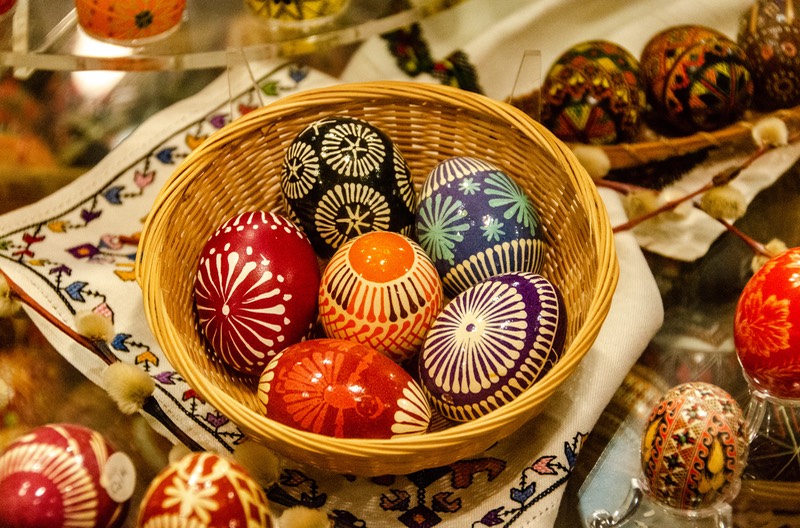
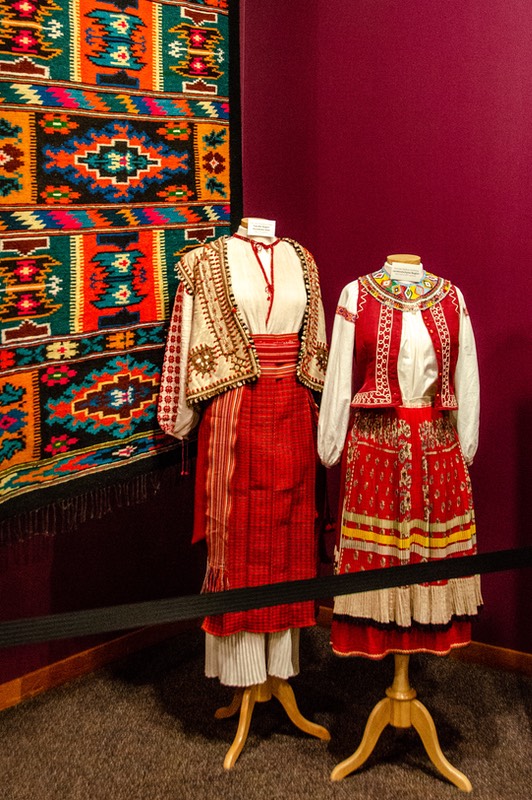
We went on into Saskatoon to visit the Canadian National Ukrainian Museum — boy that was fun. We had a wonderful time and made some new contacts with folks working there. It’s a swell museum, although rather dated. They told us that in the fall they were going to commence a long overdue updating of the exhibits. Didn’t matter to us, we enjoyed ourselves a lot. The colorful clothing, painted eggs, wood carvings and written history were all great. They were also conducting classes of children whom they told us were indeed refugees from the war. Sadly, they didn’t have any decent flags either, but we did find a lovely carrying bag, which now contains all our Canada materials. Groovy!
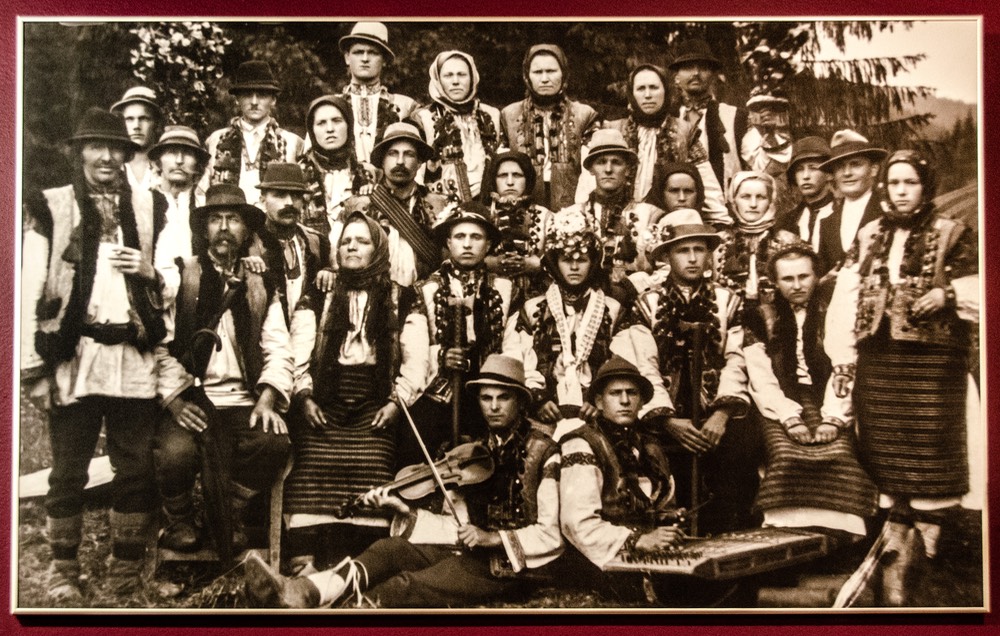
Earlier, just as we had been pulling into Humboldt last Sunday, we’d had some engine hesitations just before we’d stopped for the night, and sure enough, within 100 kms or so of moving on, they reappeared. They weren’t too frequent, just now and then, nothing too consistent; but definitely we knew they were there. They would come and go, just enough to remind us of a problem but not enough to interrupt our forward progress. Yet.
A couple of days later we arrived in Lloydminster, the town that belongs to two provinces. It straddles the line between Saskatchewan and Alberta, and spreads out over both sides. There is a line down the middle, mostly a road of sorts, but it’s sort of shrugged off. You can tell when you’ve crossed it, though, because on the Alberta side all the stores you’ve not been seeing suddenly are popping up. Otherwise? Not much difference. Oh, not to bore too much with Time Zone Trivia (the newest game around), but being situated right on the border and sort of cohabiting with Alberta, Lloydminster is the only town in the Saskatchewan province that honors DST. Just in case you ever visit.
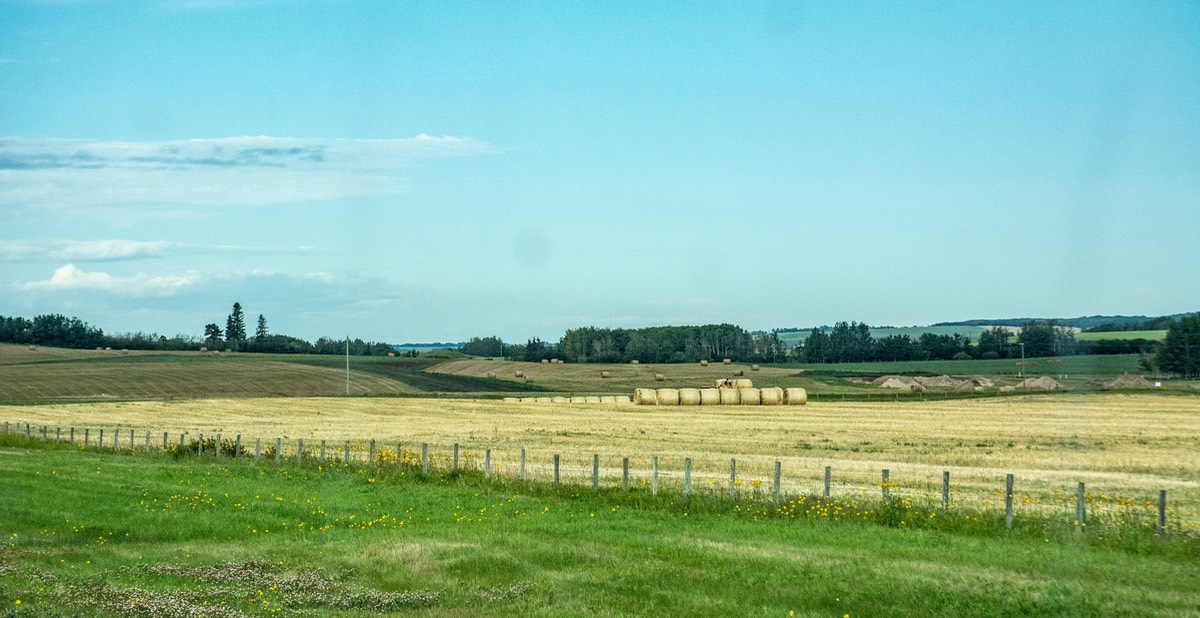
The last part of our afternoon drive into town the frequency of the engine hesitations had increased and we decided we had to begin trying to find more help. Rick called around a bit and came across a shop that was part of a chain of stores throughout Alberta and BC that had long hours and were open 7 days a week. Wow. This was especially inviting as the weekend was approaching. There was one in Lloydminster, but they were too booked up to help. They referred us to Edmonton, where they had two stores, so we decided to head there.
Alberta Province is a bit different from Saskatchewan, if you look closely. The roads are a little bit better, there are more trees in the prairie area, more cattle than before, and the crops in the fields are looking more “done” as the days go by. But still lots of grain, and still a very large Ukrainian presence. A literal “presence” if you will, was to be found in Vegreville. It is the home of an incredibly large egg, many feet up in the air, and beautifully painted. We stopped there to enjoy it, and to also enjoy the bright sunshine and blue skies with puffy white clouds. It was great. We have a picture of this same egg hovering above the Tiger from back in ’07. Cool.
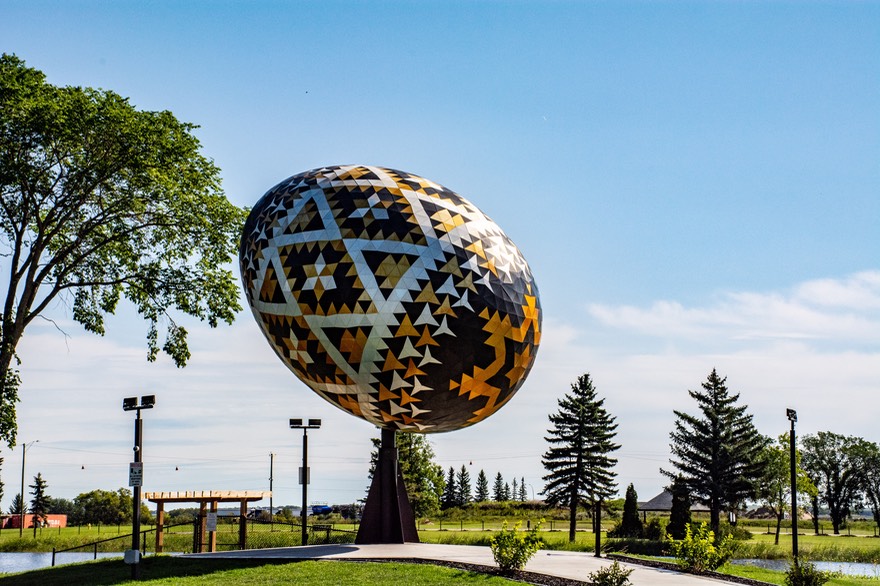
We ended up going on into Edmonton with just the occasional miss to cause alarm. By now we’d talked to our diesel guy in the states to discuss various possibilities, so when I (Rick) talked to the foreman at the diesel shop we all were on the same page. The thing is the problem was intermittent and could not be duplicated so it was still a bit of a guessing game.
After some discussion the foreman provided us with a quote to replace the fuel pump and both filters. It was more money than we wanted to spend on something that everyone agreed might clear itself up over time — so we held off. This turned out to be a mistake.
While in the Edmonton area, we did manage to get to the one museum we’d been working on getting to for years, the Royal Alberta Museum. We’ve been reluctant in the past because of the difficult traffic and street issues — it’s smack in the middle of the downtown area, very close to the banks of the river. A bit of a mess. But Sunday seemed like the time to try; and we really didn’t have any problems. Rick has become very proficient in getting the coach in and out of tight spots. So off we went.
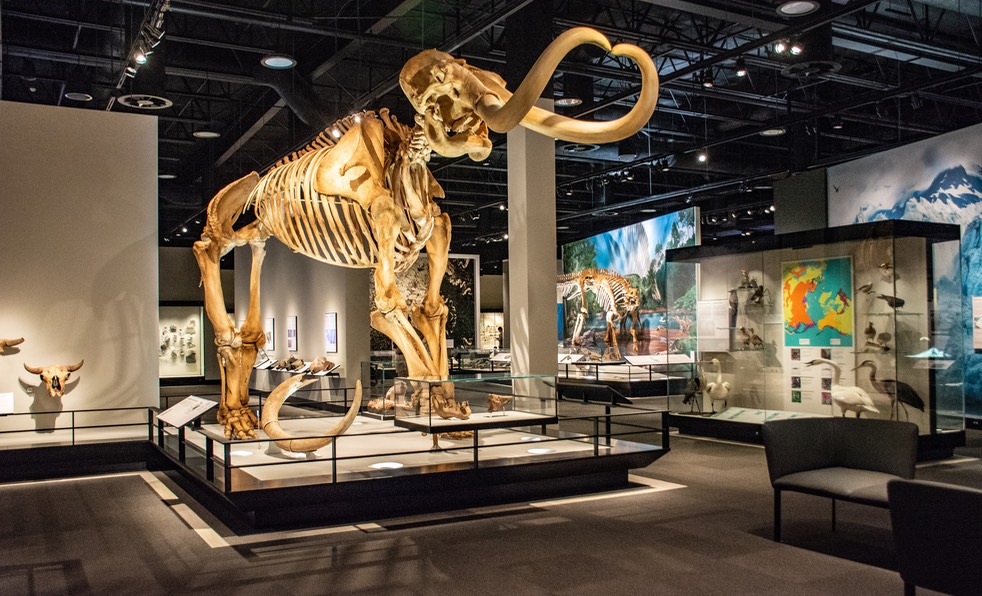
And the museum was absolutely outstanding. A very special place, it is a natural history museum with fantastic skeletons of dinosaurs displayed in large spaces with excellent lighting, lots of evolutionary information on the flora and fauna of this part of Canada, and wonderful displays of the rocks and minerals of the area. It is also a human history museum illustrating man’s settlement of the region. It being a Sunday, we had parked for free in the downtown area. And found we were right next to a nice car show and a farmer’s market. So after the museum, Rick wandered the cars while Kathy checked out the produce stands before we moved on.
There were sights to be seen in the area around Edmonton and we also wanted to put some miles on to keep tabs on our ongoing fuel problem without getting too far away. So we wandered through the town of Radway to see a recommended “specially refurbished” grain elevator. Well, not so special, but enjoyable anyway, and then on to Lamont to see their nice old church. A couple of small but pleasant stops.
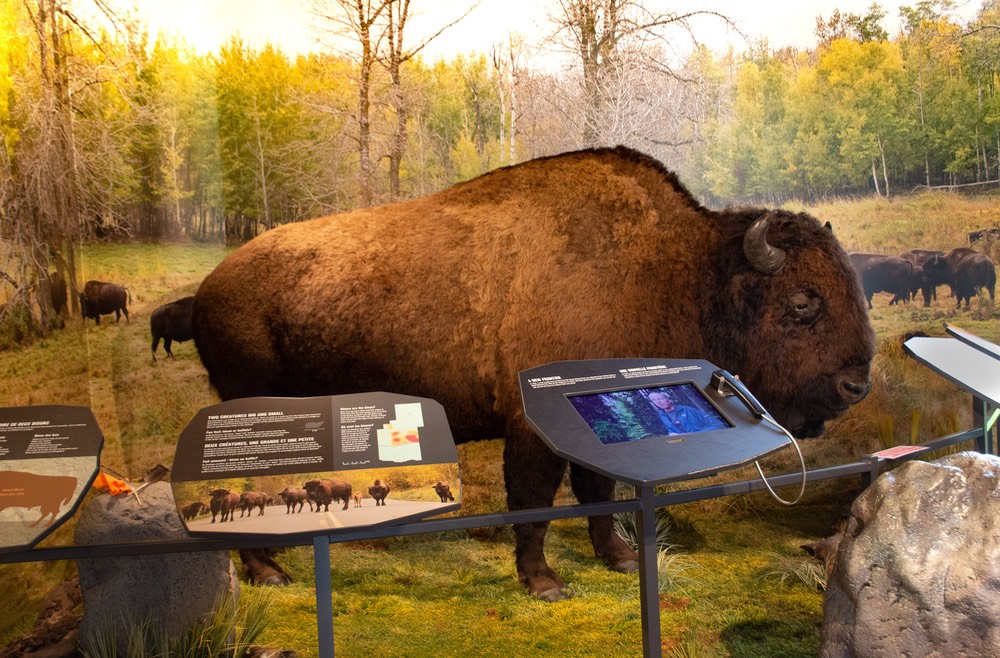
Most importantly we wanted to get over to Elk Island NP, which was quite a nice spot, and not all that far away. Elk Island should probably have been named Bison Island, but they have some Elk too. The reason is that this refuge was established in large part to protect the remaining Plains and Wood Bison, which had been badly decimated historically. One of the early park veterinarians established a program to check the herd not only for disease, but also for contamination - cross breeding - by cattle. Over the years, it has been so successful that in the early 70s the herd had been certified healthy and pure and as a result the reserve has been able to ‘cross pollinate’ with herds in many parts of the world, improving the purity of bison stock everywhere. Bison from Elk Island have been “translocated” to parts of eastern Europe and Asia, as well as into various areas in the United States. It’s a wonderful program. A small park, we weren’t there long, but it was very interesting.
Having seen what we had come to see, and believing that our problem was under control, we left Edmonton and headed straight south through central Alberta, heading for Calgary and, eventually, back into the western US. Or so we thought.
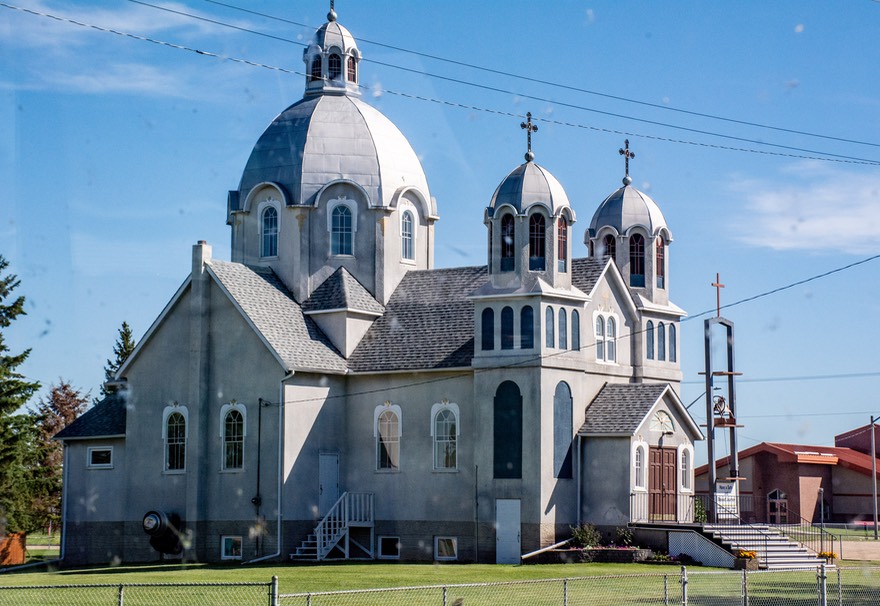
That afternoon the engine began to miss regularly and Rick decided we could not continue any further. After another discussion with our expert in Oregon, we turned around and made the now two-hour drive back to Edmonton to make the repairs. We called ahead to let them know we were coming and to gather the necessary parts. They operate on a first-come first-served basis with no appointments, and with their long hours we felt they could get us in that afternoon, and indeed they did. With just a few more small hiccups they got the work done for us, we paid the bill and turned south once again. The engine continued to run smoothly and it seemed apparent that this time the problem had been solved. Hey, it’s only Canadian money.
We finished our zig-zag up and down the central section of Alberta Province. And, were able to spend time at one more nifty Canadian museum, the Reynolds Museum located in Wetaskiwin. We’d been here once in our early years on the road and had been looking forward to a return visit. We puttered our way around the museum, which was a very large assemblage of interesting stuff — cars, airplanes, enormous farm machinery (including an gigantic steam engine out in front), and much more. There were old films of how a grain elevator works, and you could stand inside a replica of one and learn all about their operation. We both had a lot of fun.
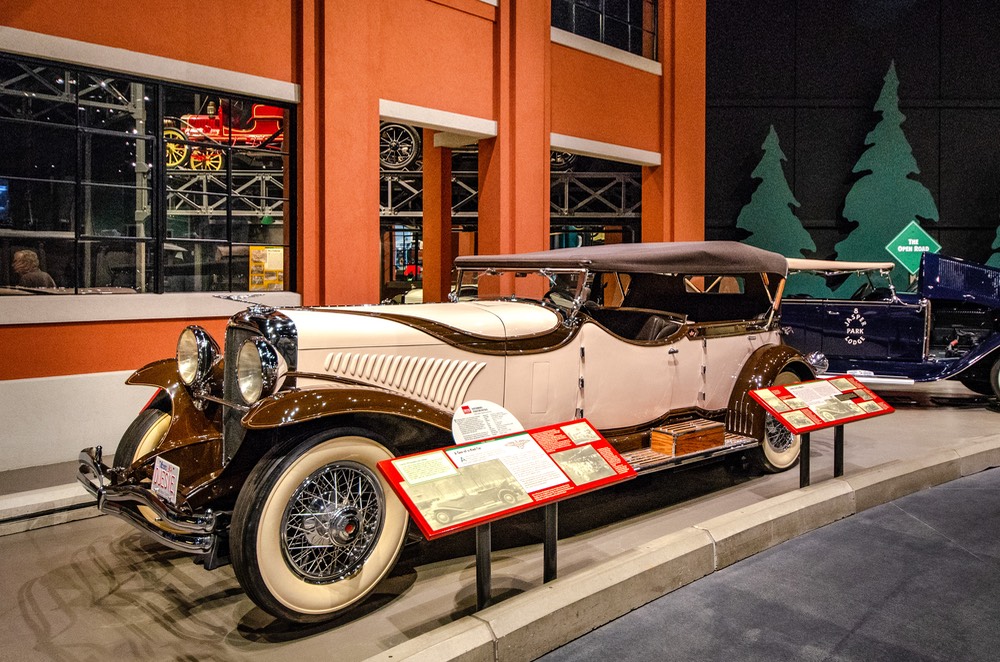
Ultimately, getting the bit between our teeth, after a few days of no more hiccups, we decided it was safe to leave Alberta. We kept moving further south, and then, below Calgary we started west towards the edges of the Canadian Rockies. Once we’d gotten out of the central corridor, below Calgary, Alberta was much more interesting and rural and it was a pretty drive. We’d been through here before over the years, and it was nice to return. The sky began to darken as we started seeing some clouds, and then smoke. We picked up Highway 3, which goes “over” the southern tip of the Rockies in Crowsnest, which has become quite a tourist area, and not very interesting. As we went west, we were seeing many vehicles coming east. And the smoke kept getting worse.
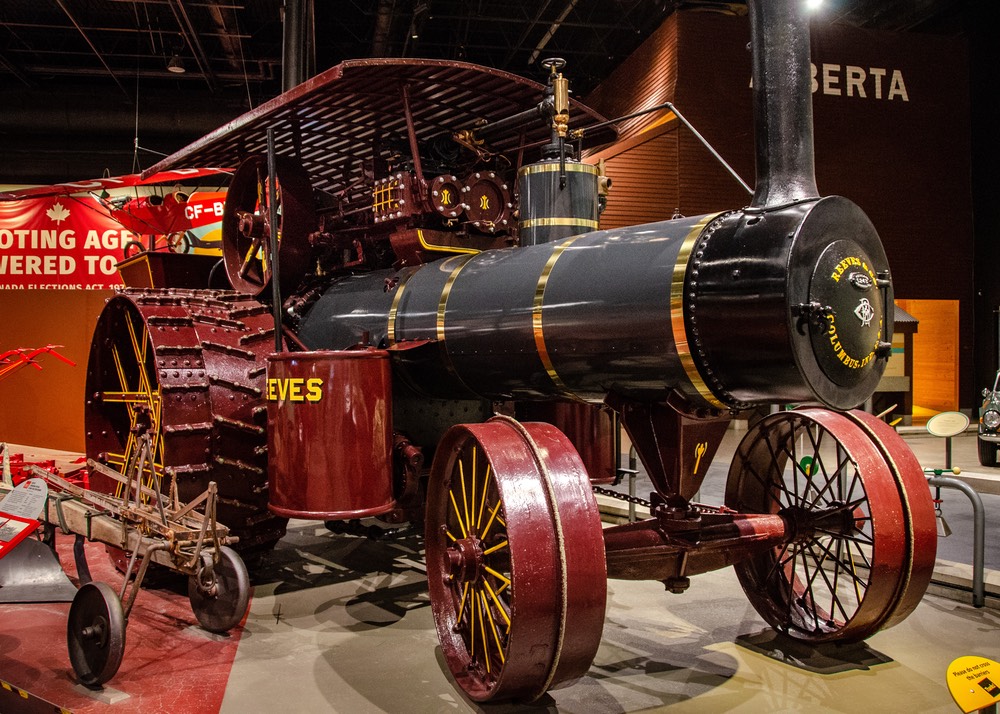
We crossed into British Columbia, and spent the night in a pretty little spot along the Elk River near Fernie, a winter resort area that was quite nice. The next day we wandered west a bit further, then stopped to reconsider what we were doing. At this point we had reservations at a nice little campground in the Idaho Panhandle. But in researching the current situation, the smoke was very bad in that area, just as it was everywhere else in the northern Rockies west of Glacier National Park. Hmmm. And what we did not know then was that just a couple of days earlier two new fires had burst into existence in the area around Spokane, Washington.
So we said, well, where isn’t it smoky? Back where we came from, of course — southern Alberta. And then we could go south, back into the States, down into western Montana. Well, what should we do? Cancel the reservation and go to Montana, we decided. So we did just that! Another ‘left turn’ added to the log book.
So we drove back east a hundred miles or so and then down a little, little road (Route 6) south from the town of Pincher Creek, and through the small border crossing back into the States. This time she took our eggs — and the citrus too. The perilous lives we lead.
Though filled with changes of plans, we’d really enjoyed our five weeks in Canada; and had especially enjoyed Saskatchewan. Never again, we said, would we need to puzzle over which province was which in Canada’s prairie region. No Sir, now we knew where Saskatchewan was and we could spell it, too. After that, Manitoba is easy.
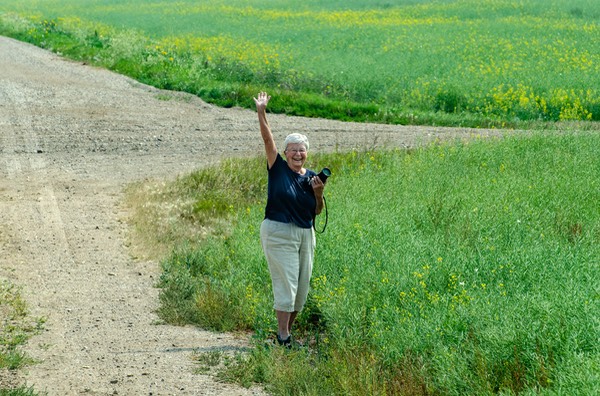
After a couple of days, we’re now settled for a bit on the east side of Glacier National Park. It’s just as nice as always, although we aren’t planning any adventures here. What we’ve needed was a time to rest and prepare for what’s next. And get this message out to y’all! You’re gonna forget who we are if we don’t get busy. So enjoy hearing about our Prairie Adventures, pick out your favorite grain silo, and memorize how to tell the difference between canola and flax in the field. We love ya!
Rick and Kathy on the go again with Slim Charles, who’s feeling better now
PS: It should come as no surprise to any of you that we are still working on getting used to traveling in such a much larger vehicle. We still turn into parking lots we probably shouldn’t and still wander off on dirt roads and into narrow camping spots with brush scraping the sides of the coach. We know we should change our style of travel, but don’t want to. So, we’ve given Slim Charles a nickname. Sometimes we call him…
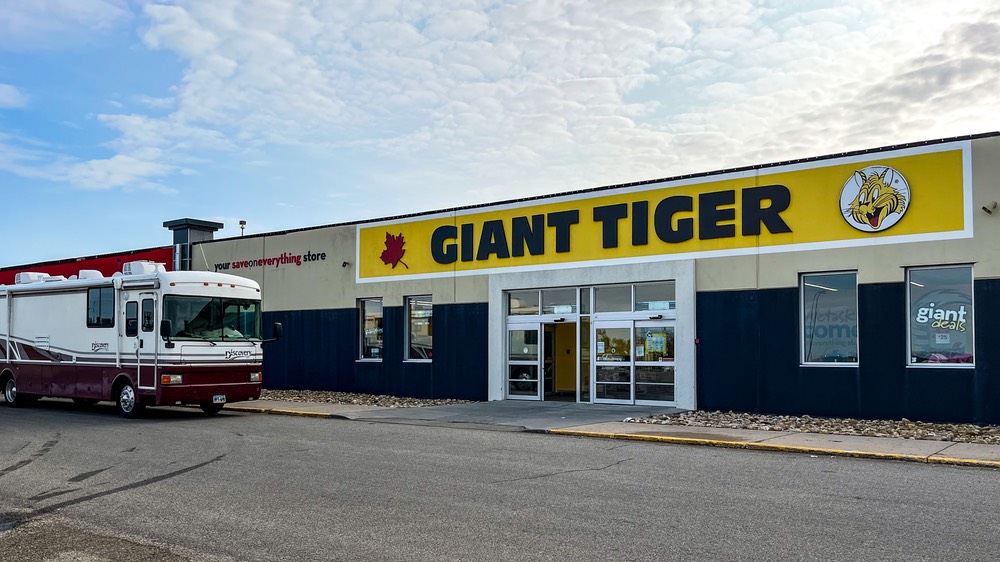
Please visit the Photo Page for this story.
We must have had a good time, because we took a lot of great pictures.